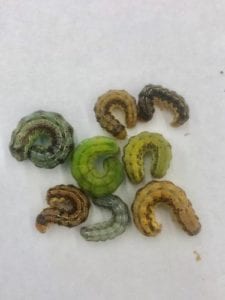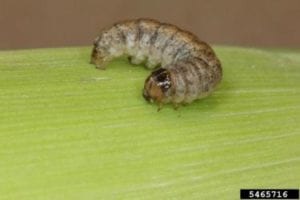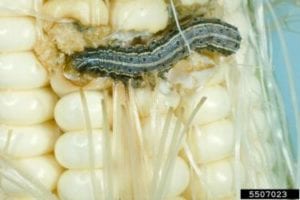
Corn earworm always have an orange head capsule, but their body can be a variety of colors. Photo by Ashley Dean.
Extra caterpillar activity has been observed in soybeans so far this year and experts from Iowa State University expect late-season infestations in corn. Caterpillars feed on the ear or tunnel into the stalks, and that feeding can lead to secondary infestations of additional pests as well as increased risk for ear molds and mycotoxins. If you have not started scouting your fields for ear-feeders, now is the time to do so. Once these pests have invaded the ear, it is too late to treat for them in the present year.
Corn earworms, European corn borers, western bean cutworms and fall armyworms all enter the ear by chewing through the husk or via the silks. Scout for destroyed or missing kernels as well as the presence of insect waste (frass). Ear molds, mycotoxins and picnic beetles may be seen as a result of infestation.
Corn earworm
Corn earworm (CEW) typically produces a large amount of frass, so look for mushy, tan, wet waste near the silks or on the husks. CEW start feeding on silks and move inside the husk to feed on the ear tip or the side of the ear. A cannibalistic pest, CEW tend to be single-occupancy dwellers on each ear.

European corn borer has a black head capsule and brown body. Photo cred: Frank Peairs, Colorado State University, Bugwood.org.
European corn borer
European corn borer (ECB) will feed on every part of the corn plant except the roots. It is most likely to burrow into individual kernels or the cob. ECB also tunnel into the stalks, where older larvae overwinter.

Western bean cutworm has two thick, dark stripes behind the head. Photo by Adam Sisson.
Western bean cutworm
Western bean cutworm (WBC) tend to be found on corn grown in sandy soils. WBC typically feed on the ear tip or side of the ear. WBC generally leave an entry hole through the husk on the side of the ear, but also enter through the silks. Multiple WBC can be found on a single ear.

Fall armyworm has a distinct ‘Y’ shape on the head. Photo cred: Phil Sloderbeck, Kansas State.
Fall armyworm
Similar to other species, fall armyworm (FAW) teed on kernels at the ear tip or side of the ear and also chew entry holes in the husk.

Picnic beetles are dark, usually with four orange spots on the wings. Photo by Joyce Gross, UC Berkley.
Picnic beetle
Picnic beetles tend to feed on previously injured spots and are typically found after other pests have vacated.